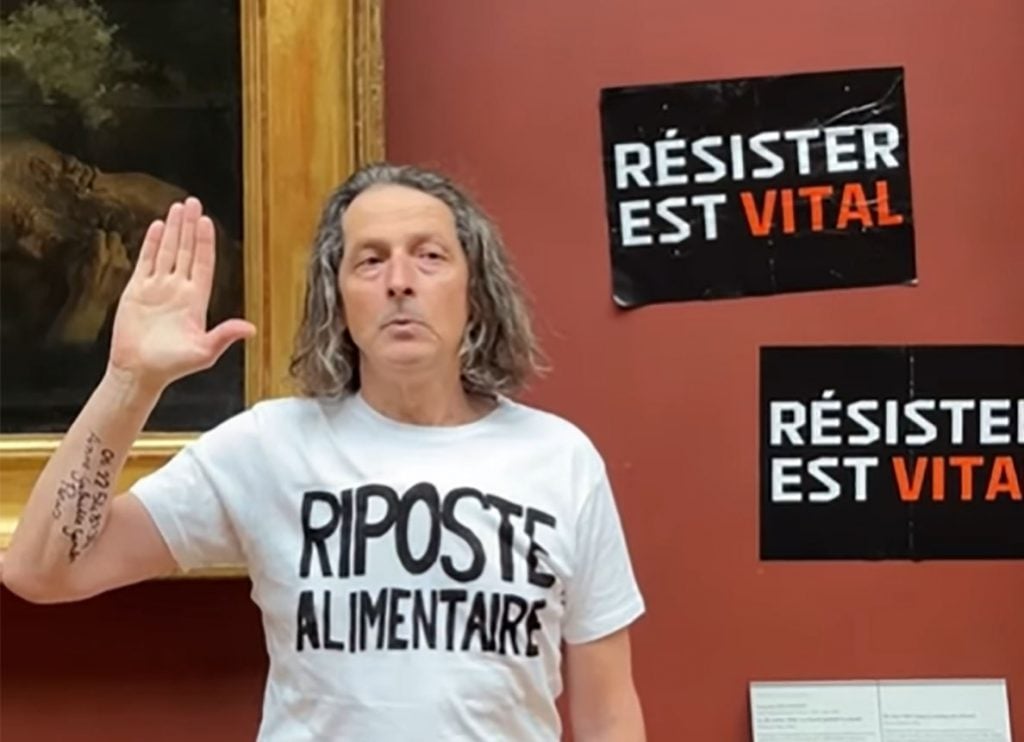Museums & Institutions
Activists Arrested After Targeting the Louvre’s Delacroix
The same group had staged an action at Versailles days ago.

The same group had staged an action at Versailles days ago.

Adam Schrader

Activists with Riposte Alimentaire, a group that advocates for measures to address food security and inequality, has targeted the Louvre Museum after protesting at the famed Château de Versailles last week.
Two activists threw orange powder in Versailles’s Hall of Mirrors on May 4, just days before another two put up stickers on the wall next to a painting by Eugène Delacroix that read, “Resisting is Vital.” According to the Agence France-Presse newswire, the two Louvre protesters were arrested, despite the museum stating the Delacroix painting was not damaged.
The work, Liberty Leading the People (1830), was created by the artist to commemorate the July Revolution of 1830, which toppled King Charles X, whose reign was marked by ultra-royalist policies. The painting was likely targeted because it has become a symbol of revolution and the fight against oppression. It had just been rehung at the museum after a six-month restoration to remove eight layers of varnish that had yellowed over the centuries.
“Even today, the criminal elites are gorging themselves on our backs. Uniting and resisting them is vital. Let’s enter into civil resistance! Let’s not let a privileged minority decide our future,” the activist group said on social media.
🦺 ACTION EN COURS – PARIS
Mercredi 08 octobre. 11h30
1 citoyen et 1 citoyenne soutenant Riposte Alimentaire ont collé des affiches à côté du tableau mondialement connu “La Liberté guidant le peuple”. On pouvait y lire “Résister est vital”. #A22Network #RiposteAlimentaire [1] pic.twitter.com/oFnJUu4tEe
— Riposte Alimentaire (@riposte_alim) May 8, 2024
In another post about the Versailles protest, Riposte Alimentaire deliberately called back to Versailles’s connection to the French Revolution as it remarked about the “minority who monopolize power and money while the people starve.”
The French Revolution was primarily fought due to widespread discontent with the absolute monarchy, extreme social inequalities, financial crises, and famine with Versailles, the opulent royal palace where King Louis XVI lived in luxury while his people starved, symbolizing the inequality that spurred the revolutionary movement.
“Through this action, Riposte Alimentaire wishes to draw attention to the growing inequalities that allow a privileged minority to monopolize a portion of resources, while the majority of citizens reap the crumbs,” the activist group said.
The group pointed to a bill to be debated by the French National Assembly beginning May 14 as a “perfect example” of the greed among upper class French leading to food insecurity for the poor, arguing that it facilitates “the monopolization of natural resources and pushing ever further towards productivist and industrial agriculture.”
“Once again, our government is choosing to favor the wealthiest farmers, thanks to the support of the FNSEA, while recent farm revolts have shown that a radical alternative to our agricultural and food system is urgent and necessary,” the activists said.
Riposte Alimentaire is calling for the creation of a Sustainable Food Social Security system, modeled on the 1946 Social Security system. It previously claimed responsibility for throwing soup at the Mona Lisa at the Louvre Museum last January and at Monet’s Spring (1872) at the Musée des Beaux-Arts in Lyon the following month.